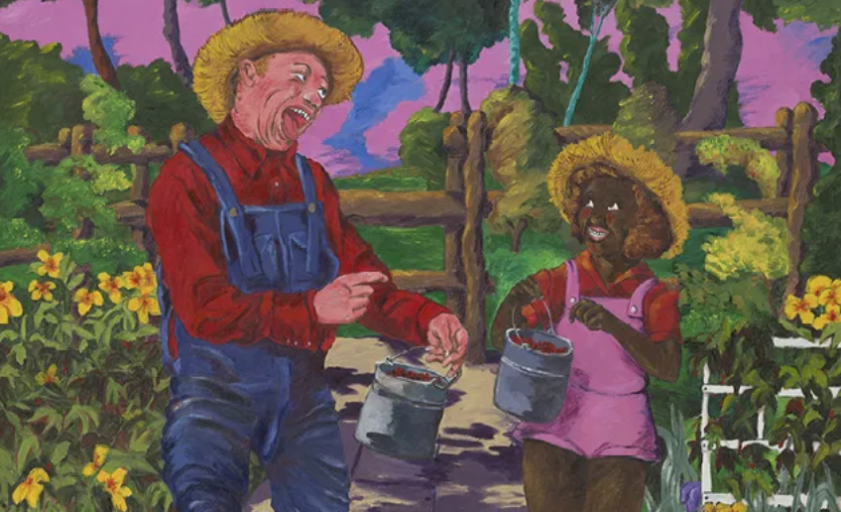By Jonathan Talit
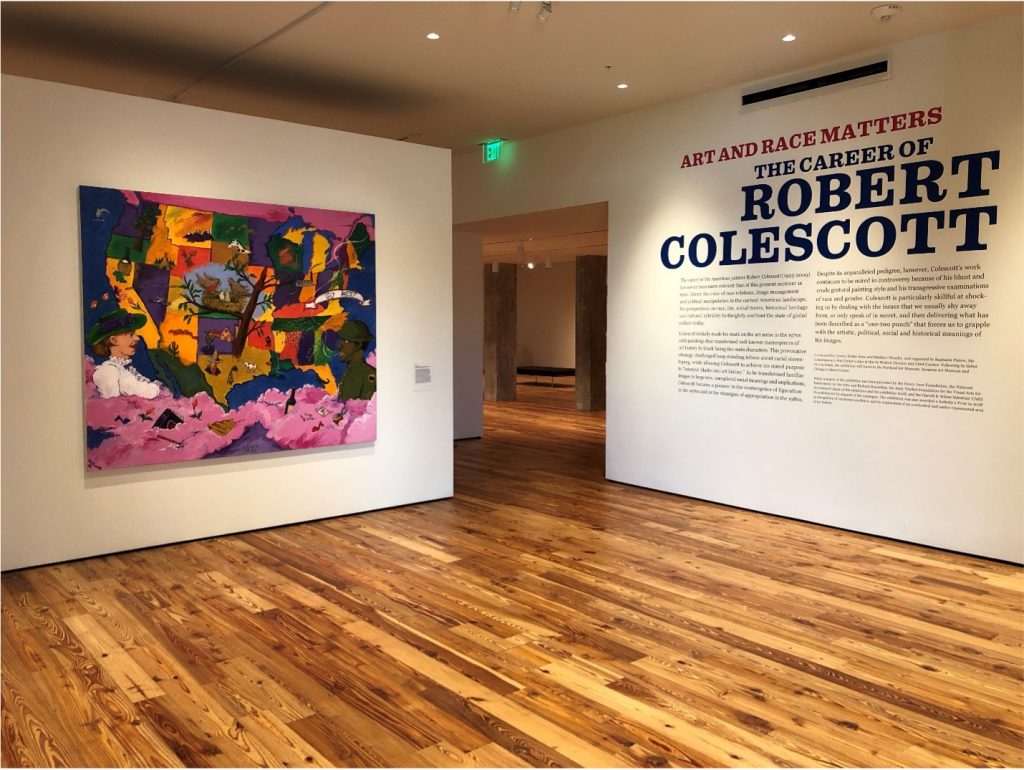
All photographs courtesy of the author unless otherwise noted.
Establishing the Sarasota Art Museum was a lengthy process that began back in 2003. After two years of speaking with community leaders in the arts and education sectors, the Sarasota Art Museum joined forces with Ringling College of Art + Design. Their decision? To transform the historic 1926 Sarasota High School into an art museum and education space. The school was originally designed by M. Leo Elliott but features a mid-century addendum created in 1959 by Paul Rudolph, an architect whose influence is still seen today in Sarasota. In 1996, classes officially moved to the current Sarasota High School, leaving the previous building abandoned for nearly 20 years. There were talks of demolishing the building until thirteen Sarasota volunteers, partnered with the Ringling College of Art + Design, petitioned for it to be transformed into an art museum.
The Sarasota School Board unanimously awarded them the building in 2004. From there, years of rigorous fundraising were required to begin renovations on the building. Over $22 million was raised by 2014. In 2015, they brought on Anne-Marie Russell to serve as founding executive director and chief curator, a position she held for six years. Russell oversaw the final renovations, the museum opening in December of 2019, as well as exhibitions and other programming through 2022. This includes Art and Race Matters: The Career of Robert Colescott.
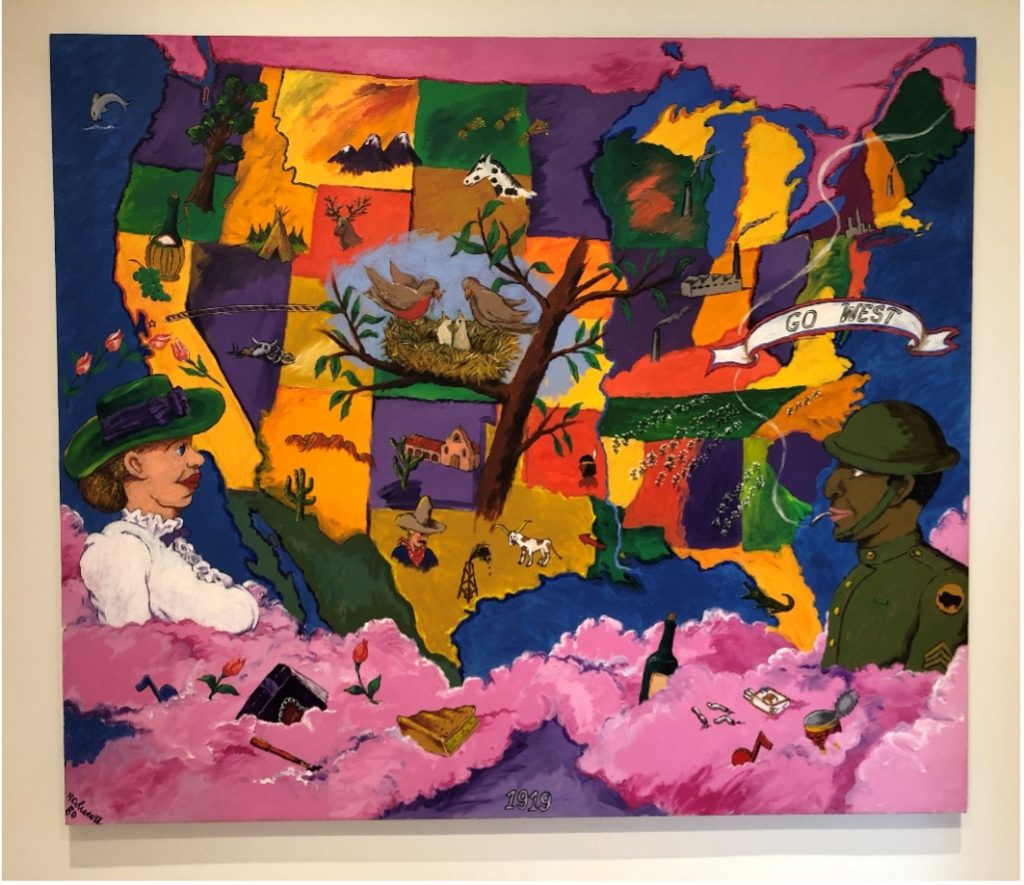
The first painting in the Robert Colescott exhibition is the first thing on most of our minds lately: America. Regardless of one’s political position, it is difficult not to see events in our country over the past few years as anything other than grim, claustrophobic, and without clear resolution. 1919 (1980), Colescott’s painting of the continental United States of America, presents our massive and varied slab of land, still curiously bound together somehow, at least on a map. The rendering of this map is not bleak and dreary, however, but throbbing with vivid technicolor. Each state is granted its own color that is different from the surrounding states, emphasizing contrast. Some states are stamped with images symbolic of their culture: an alligator in Florida, a bottle of wine in California, an ox skeleton in Nevada, charmingly rendered. The map is flanked by two figures in profile who are only visible from the chest up. The rest of their bodies are submerged in a billowy mass of cotton-candy clouds, sprinkled with “studio sweepings” like cigarette butts and opened cans. The figure on the left is a white woman, hilariously buxom, and the figure on the right is a Black man in uniform. Evidently, these are the artist’s parents, who are also symbolized in the bird’s nest image in the center of the painting.
There are a lot of tropes here: 19th-century silhouettes in the figures in profile, state symbols on children’s maps, the “melting pot” of America formed by distinct cultures, and the latent but potent tension between Black men and white women in our country. 1919 certainly taps into the unsightly race relations that helped form and maintain the U.S. but it’s with a light touch. As the exhibition progresses, Colescott becomes increasingly direct about his positions regarding race, the history of painting, and American popular culture. This cocktail of uncomfortable social commentary, crude figuration, and a lush color palette is Colescott’s modus operandi. Like Paul Mooney and Robert Crumb, Colescott aims for the status of great comedy by presenting these blunt and jagged truths with a sense of levity and even glee. Essentially, he’s his own straight man and funny man; Laurel and Hardy in one painterly package.

It took a while to get there, however, and the exhibition traces Colescott’s history succinctly. Born in 1925, Colescott doesn’t develop his signature style until the 1970’s when he was well into his forties. This is peculiarly late for an artist to “find their voice,” particularly when individual styles were so prized in the mid-20th century. A room in the exhibition dedicated to Colescott’s early work presents a serious student of art history, from Manet to Matisse to Léger (a teacher of Colescott’s). These paintings are mostly executions of the styles of other artists, if not copying specific artworks altogether. One exception is a small painting, Untitled (1949), made while Colescott was a graduate student at UC, Berkeley. It’s a small work of geometric abstraction that is an early cue of Colescott’s later strategies for organizing compositions and his affinity for pink. The rest of the work documents Colescott’s attempt to find his point of view through other artists. Fake it ‘til you make it. All artists go through this, but Colescott’s lengthy growing pains risked him becoming a permanent student of art history: a practitioner of the values of others instead of synthesizing his own.
That all changes after an extended stay in Egypt beginning in 1964 where Colescott became the first artist-in-residence at the American Research Center in Cairo. It’s always a little slippery to deduce clear cause-and-effect from an artist’s life to their work, but with Colescott, it’s pretty case-closed. There is a dramatic shift in formal concerns and sensibility that result from Colescott’s five-year stint in Egypt. The paintings become larger, the colors more saturated and delicious, and the figures less realistic yet full of life somehow. Dr. Ehrlich’s Magic Bullet (1968) is an early example. This is the beginning of the “cartoonish” style for which Colescott is remembered. Something about Egypt awakened his childhood love of color and comic strips (I suspect Egyptian hieroglyphics and ornate linen are to credit). It’s apt that Pop Art and psychedelia were occurring simultaneously in the States and the UK while Colescott was in Egypt. The social revolution of the 1960s was also brewing, exploding into the Civil Rights Movement in America and Second Wave Feminism in the west writ large.

This leads to another clear awakening for Colescott in Egypt: race. It seems that moving from the Pacific Northwest to Cairo forced Colescott to confront, accept, and celebrate his own bi-racialism. This, paired with his beatnik influence after moving to Oakland in 1969, focused Colescott to present these issues with a crass, cheeky sense of humor and almost hallucinogenic imagery. Sprinkle in some appropriation from art history and American popular culture, along with the occasional flashes of self-reflection and autobiography (see Bad Habits from 1983), and voila: you’ve got an artwork by Robert Colescott.
Colescott is extraordinarily productive once he finds his groove. The exhibition is replete with examples of Colescott keeping his basic ingredients but playing with the proportions. Cactus Jack in El Dorado (1977) amps up the transparent use of stereotypes, in images and text, but dials back the viscous painting style for which Colescott is best known. The painting’s crisp colors and flat rendering narrow the attention to Colescott’s matter-of-fact delivery of stereotypes, inducing an appropriate discomfort. Even the scenery is a stereotype of the American landscape and desire to head west.
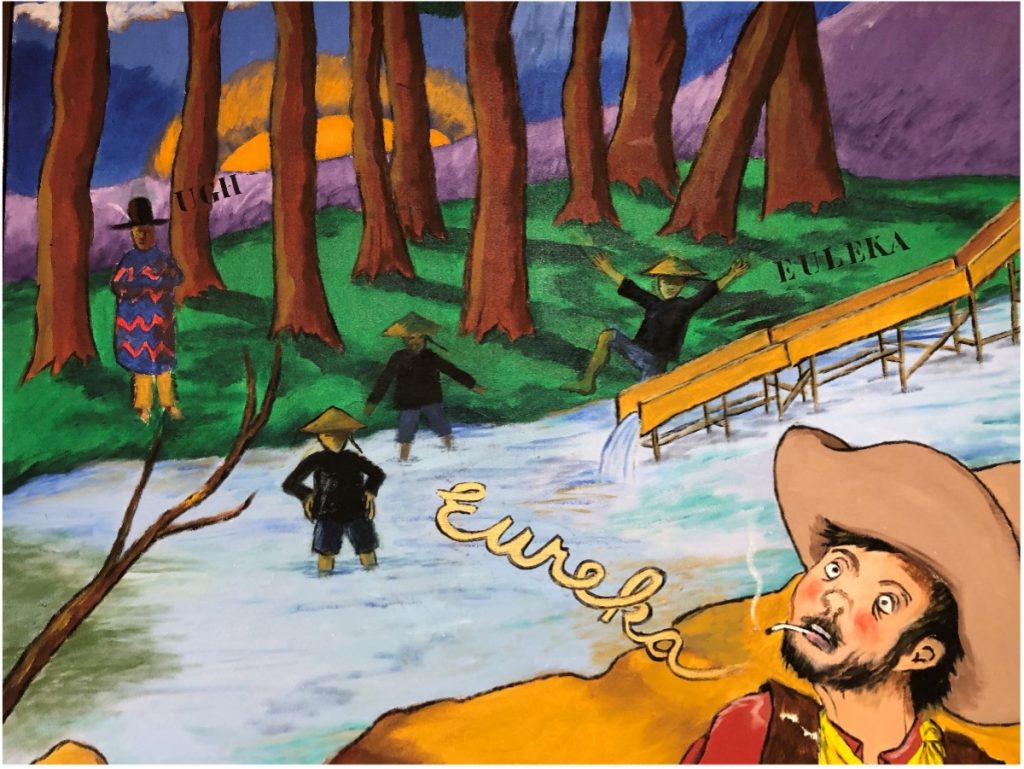
Hard Hats (1987), by contrast, relishes in cloddish, lumpy figures but doesn’t reduce them to signs or stereotypes. Instead, Colescott presents a rather intimate scene of solidarity between a wife and her husband, a construction worker and his coworkers, Americans and their fellow citizens. “We’re all building this together.” While the comradery is definitely visible, so is the looming fear of collapse. Hence, the hardhats. When is this whole thing going to tumble?
Some paintings eschew any immediate story altogether. Sleeping Beauty (2002), a large diptych centrally mounted in the exhibition, appears more interested in marks rather than images. Reduced and swift, the marks made on the canvas tempt the viewer to decipher any specific reference but are ultimately illegible. The painting has a sweeping sense of time that is enhanced by its large scale. It invokes the history of recording touch, from cave paintings to Abstract Expressionism, but isn’t particularly located in the specific project of America that concerns the rest of his work.
These paintings, however, are examples of Colescott’s deep cuts. They meander slightly from his primary “one-two punch” strategy: presenting the audience with cherished imagery and symbolism that connects them to their childhoods and rosy-eyed views of America, then immediately injecting the garish, foul costs of that imagery without any clear path towards reconciliation. They get the sweet and the bitter.
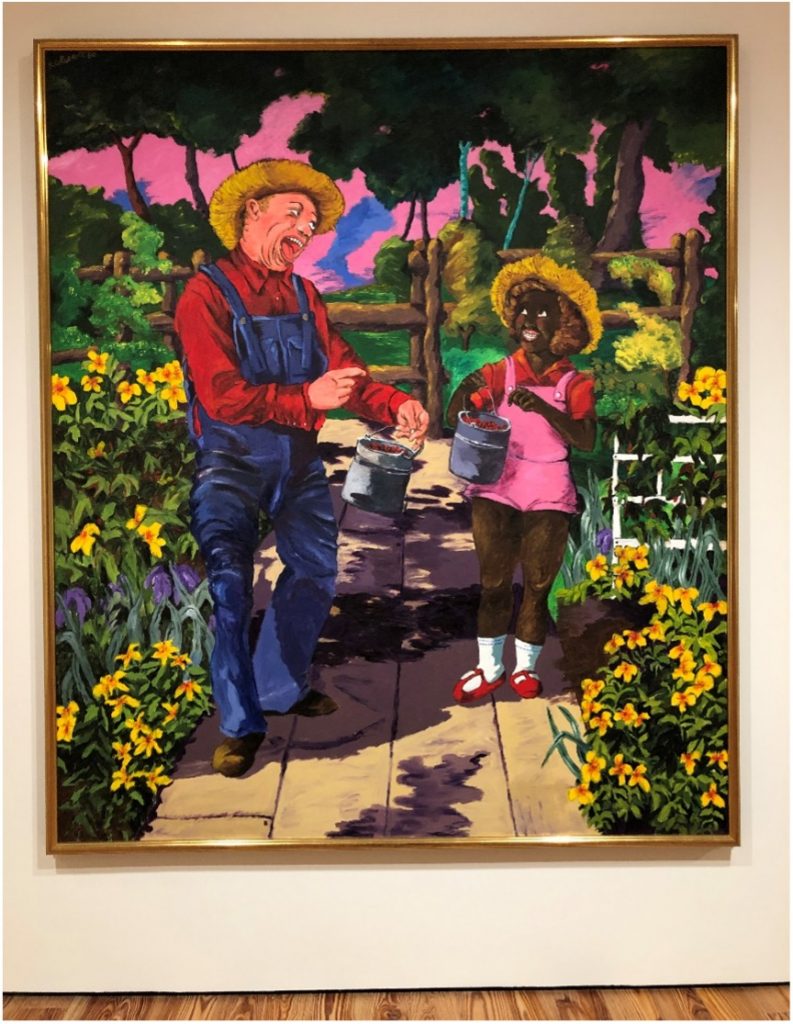
Or at least, that’s the goal. This “one-two punch” often consists of injecting Black figures into scenes in which they weren’t originally visible, like Rubens or Lichtenstein paintings. Sometimes Colescott is even more upfront by portraying white figures as Black and vice-versa. Shirley Temple Black and Bill Robinson White (1980) is an example. Here, the famed actor/tap dancer ambles through a garden with the iconic child star of the 1930s. It could easily be a scene from one of the several movies they made together except that 1) the scene is in color and 2) their races are switched. Colecott’s intense color palette, drenched in saturation, amplifies the feeling of disorientation. The figures, however, are some of Colescott’s most realistically rendered. The result is a painting that is acutely abnormal. Besides the disarming switch of the figures’ races, the friction between the cartoonish colors (the background sunset looks like something straight out of The Simpsons) and the more focused realism of the figures confuses fantasy and reality. Don’t movies do this, too? There’s got to be a Wizard of Oz joke deep in this painting; the double entendre of switching from black and white to color when Dorothy arrives in Oz. The painting contains a remarkable stillness, as if frozen in suspended animation. A tonal remix occurs, too. Robinson’s laughter reads more like horror and Temple’s luminous enthusiasm comes off more withholding and cautious.

They aren’t all hits, however. The Judgement of Paris (1984) uses the same “one-two punch” but just comes off rushed. Colescott had a fine line to walk: how to employ clear strategies of appropriation but not become utterly formulaic. The Judgement of Paris wears its formula on its sleeve: steal a title and composition from a canonized painter, usually a white male, and make one or all the figures Black! That’s a fine place to start, but The Judgement of Paris doesn’t really go anywhere with it. It doesn’t transcend this formula. The paintings have to offer more than the sum of their parts, and with Colescott they usually do. If not, the humor flattens, the point is cheapened, Colescott’s hard-earned voice is lost, and the painting quickly sums itself up. Yawn.
However, the final room that contains The Judgement of Paris does present other work that successfully complicates Colescott’s practice. Colescott’s signature oeuvre relies on this “one-two punch” that the viewer, ironically, is continuously hit over the head with throughout the exhibition. The idea being that Colescott shows us what these symbols from history books, Disney movies, and magazine advertisements really mean. He, the insightful artist and enfant terrible, reveals the truth of our complicity to us. Without him, perhaps we’d be lost in our personal fantasies and delusions of grandeur; fantasies in which we’re the heroes, of course. That’s fine, but it’s just fine. The show becomes richer when Colescott points that outward perception a little closer to home, making tidy, moral judgments tougher to deliver. After all, it is his work that relies quite heavily on stereotypes, on appropriating charged imagery that already exists only to alter it slightly, if at all.

Perhaps Colescott never completely developed his own unique strategy for creating images outright. Whether it’s through Rubens or Shirley Temple, Colescott almost always needs a pre-existing vehicle through which to express his ideas and attitude. A series of drawings called Lone Wolf Trilogy (1974) makes this compromise well. Colescott steals the stereotype of a dapper, randy wolf, originally made popular by famed animator Tex Avery. With a lengthy and lascivious grin, the wolf is always standing confidently, puffing on a cigar (shout out to Freud), and dressed to the nines. In case it wasn’t already clear what the wolf is hungry for, Colescott draws an obvious dick print in the wolf’s pants. His legs spread wide exacerbate his intentions: he’s ready to deliver.

Colescott uses one of these drawings as a template for the painting Lone Wolf in Paris (1977). Here, the wolf is dancing with a blonde woman at a restaurant. Orbs of light (spotlights?) focus on the couple as the wolf dips the woman, an iconic and erotic position in salsa dancing. His once obvious erection is obscured the bent body of the woman, but sexual symbols linger. What else could those stiff candles, slowly dripping milky wax, be there for? The shadow underneath the dancers, an amalgam of intertwined forms, predicts more shapes and contortions that the dancers will take on later when they find someplace a little more private.
Of course, the wolf is Robert Colescott. Whether it’s how he saw himself, or how he wished he did, or both, who knows. Regardless, what’s successful about these drawings and the resulting painting is their sharp humor and lack of judgment. Colescott understands the pleasure of being a horndog and the resulting complications of it. It’s possible that the work in this room reveals Colescott to be even more reflective. What if stereotypes are often unfair representations with real consequences and pleasurable to slap onto others? If one needs a clear takeaway or lesson from an art exhibition (I don’t), this one offers a useful quandary: how do we attempt to make a better world for each other, whatever that means, while accepting our innate appetites to segregate and flatten each other into caricatures? What if America isn’t as pretty and fluffy as we’re sometimes told it is, but that’s because we aren’t either and never will be? Not in some high-minded, academic way, but in our tedious, daily negotiations with our egos and various thirsts?
In a culture where image management is high currency and many people, perhaps artists most egregiously, are constantly manicuring their morality on “the public stage” like a bird preens its plumage, Robert Colescott reminds us that manicures only go so far. In fact, they could even be detrimental in their disguising of the malformed and grisly impulses that run through all of us. Like all good art, Colescott’s work provides an opportunity for integration: to work on a better, more equitable world for all while acknowledging the quiet rumble in our bellies at the cheap pain of others; our animal eyes glowing in the dark.
Art and Race Matters: The Career of Robert Colescott, curated by Lowery Stokes Sims, Raphaela Platow, and Matthew Weseley, was organized by the Contemporary Arts Center in Cincinnati. The traveling exhibition is on view at the Sarasota Art Museum through October 31, 2021. For additional information and related programming, visit the museum’s website.
Bay Art Files contributor Jonathan Talit is an artist currently based in central Florida. He received his BFA from Boston University and recently received his MFA from the University of South Florida, Tampa. He makes sculptures, essays, exhibitions, friends, fun, and occasionally money.
